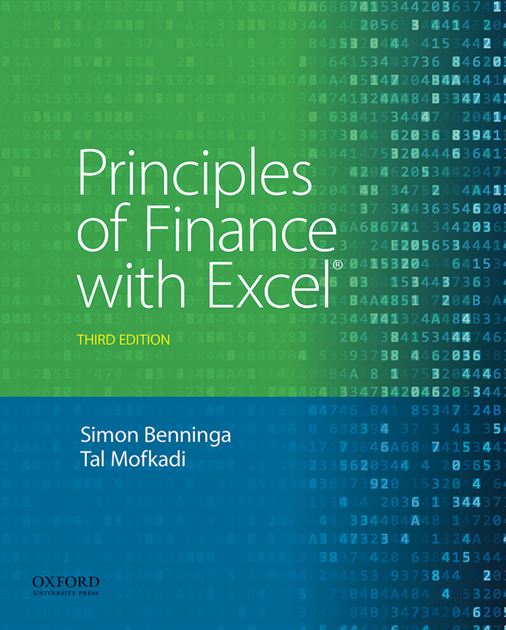Principles of Finance with Excel

Principles of Finance with Excel
|
ISBN: |
9780190296384 |
|
Binding: |
Hardback |
|
Published: |
2 Jan 2018 |
|
Availability: |
38
|
|
Series: |
$199.00 AUD
$220.99 NZD
Add To Cart Request an inspection copyDescription
Offering exceptional resources for students and instructors, Principles of Finance with Excel combines classroom-tested pedagogy with the powerful functions of Excel software. Authors Simon Benninga and Tal Mofkadi show students how spreadsheets provide new and deeper insights into financial decision making.
It covers the same topics as standard financial textbooks–including portfolios, capital asset pricing models, stock and bond valuation, capital structure and dividend policy, and option pricing. For each topic, the authors provide step-by-step instruction on how to use Excel functions to help with relevant decision-making. A separate section of PFE (Chapters 21-26) reviews all Excel functions used in the book, including graphs, function data tables, dates, Goal Seek, and Solver.
KEY FEATURES
- Offers streamlined content (reduced by three chapters) that allows students to dive right into the heart of finance: time value of money and discounting
- Provides updated examples, most of which refer to the post-2008-crash financial world
- Uses Microsoft Excel 2016 throughout
- All exercises have been revised or annotated to indicate which topic that exercise covers
This title is available as an eBook. Visit VitalSource for more information or to purchase.
Contents
Part One: Capital Budgeting and Valuation
1. Introduction to Finance
2. The Time Value of Money
Appendix 2.1. Algebraic Present Value Formulas
Appendix 2.2. Annuity Formulas in Excel
3. Measures for Evaluation of Investment Opportunities
4. Loans and Amortization Tables
5. Effective Interest Rates
6. Capital Budgeting: Valuing Business Cash Flows
Part Two: Portfolio Analysis and the Capital Asset Pricing Model
7. What is Risk?
8. Statistics for Portfolios
Appendix 8.1. Downloading Data from Yahoo
9. Portfolio Diversification and Market Risk
10. Risk Diversification and the Efficient Frontier
Appendix 10.1. Deriving the Formula for the Minimum Variance Portfolio
Appendix 10.2. Portfolios with Three and More Assets
11. The Capital Asset Pricing Model (CAPM) and the Security Market Line (SML)
12. Measuring Investment Performance
13. The Security Market Line (SML) and the Cost of Capital
Part Three: Valuing Securities
14. Efficient Markets--Some General Principles of Security Valuation
15. Bond Valuation
16. Stock Valuation
Part Four: Options
17. Introduction to Options
18. Option Pricing Facts and Arbitrage
19. Option pricing: The Black-Scholes Formula
Appendix 19.1 Getting Option Information from Yahoo
20.The Binomial Option Pricing Model
Part Five: Excel Skills
21. Introduction to Excel
22. Graphs and Charts in Excel
23. Excel Functions
24. Using Data Tables
25. Using Goal Seek and Solver
26. Working with Dates in Excel
Authors
Simon Benninga – Professor of Finance and Director of the Sofaer International MBA program, Faculty of Management, Tel Aviv University
Tal Mofkadi – Lecturer, Tel Aviv University; Co-Founder, Numerics Economic and Financial Consulting; and Visiting Professor, University of Amsterdam, Vienna University of Economics and Business, and Nagoya University of Commerce and Business
Student Resources
The following resources are available for students using Principles of Finance with Excel, third edition, for their course:
- Chapter Spreadsheets
- Exercise Templates
Lecturer Resources
The following resources are available for lecturers who prescribe Principles of Finance with Excel, third edition, for their course:
- Instructor's Manual
- Lecture Notes
- Solutions Manual
Reviews
"Principles of Finance with Excel is simply the best book available for teaching financial principles using Excel. Its main competitors don't even come close."–Steve Slezak, Cal Poly
"I use Principles of Finance with Excel because I am really convinced that Excel is an extraordinary tool to teach finance. First, it helps painlessly solve problems that involve tedious computations. Second, it forces students to frame a problem in a way that fits with Excel. The major strength of this text is that it allows students to understand finance almost effortlessly."–Fabrice Riva, Université Lille 1, France
"This text provides students with an introduction to Excel skills and a good review on finance. It also helps them prepare for job markets. The third edition is more organized and focused."–Lei Gao, University of Memphis